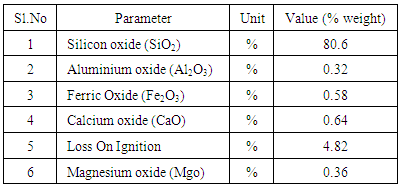-
Paper Information
- Next Paper
- Previous Paper
- Paper Submission
-
Journal Information
- About This Journal
- Editorial Board
- Current Issue
- Archive
- Author Guidelines
- Contact Us
American Journal of Materials Science
p-ISSN: 2162-9382 e-ISSN: 2162-8424
2015; 5(3C): 101-106
doi:10.5923/c.materials.201502.21
Experimental Investigations on Mechanical Properties of Cenosphere/MWCNT Reinforced Polymer Nanocomposites
H. B. Jalageri , G. U. Raju , K. G. Kodancha
Department of Mechanical Engineering, BVBCET, Hubli, India
Correspondence to: H. B. Jalageri , Department of Mechanical Engineering, BVBCET, Hubli, India.
| Email: |  |
Copyright © 2015 Scientific & Academic Publishing. All Rights Reserved.
Utilization of cenosphere in polymeric composites made the composite lighter and cost effective. Howeverthere is need to further enhance the strength and stiffness of these polymer composites. Multiwalled Carbon nanotubes (MWCNT) can be effectively used as secondary reinforcement material in polymer based composites due to their superlative mechanical properties which enhance strength and stiffness of the composites. In this work, mechanical properties of Cenosphere/MWCNT reinforced epoxy nano composites are investigated experimentally. The composites were fabricated using uniform dispersion of MWCNT and cenosphere in epoxy resin by ultrasonic energy method, with the percentage of MWCNT varied from 0.1 to 0.5 wt% of epoxy. The specimens were tested for flexural, tensile and impact properties as per ASTM standards. It was observed that good flexural and tensile properties were found for 0.1 to 0.2 wt% of MWCNT and composite with 0.5 wt% exhibits higher impact strength.
Keywords: Cenosphere, MWCNT, Epoxy, Nano composites, Mechanical properties
Cite this paper: H. B. Jalageri , G. U. Raju , K. G. Kodancha , Experimental Investigations on Mechanical Properties of Cenosphere/MWCNT Reinforced Polymer Nanocomposites, American Journal of Materials Science, Vol. 5 No. 3C, 2015, pp. 101-106. doi: 10.5923/c.materials.201502.21.
Article Outline
1. Introduction
- Due to their fabulous mechanical, thermal and electrical properties Carbon Nanotubes (CNT) have attracted composite group to explore the possibility of using them as an additional reinforcement in reinforced polymer composites. Cenospheres are used in various industries due to their unique combination of spherical shape, high compression, low specific gravity, good thermal and acoustical insulation properties and inertness to acids and alkalis. There is a further attempt to investigate the combination of CNT and Cenosphere reinforcement with epoxy resin. Literature carried out for the CNT mixed different constituent secondary reinforcement material. It is reported that as a result of carbon nanotube (CNT) modification in CNT/basalt/epoxy composites, the tensile strength and Young's modulus of CNT/basalt/epoxy composites were improved to 34 and 60% greater respectively than that of unchanged CNT/basalt/epoxy composites [1]. Recent research shows that Nano composites of high density polyethylene (HDPE) along with lightweight hollow fly ash cenospheres and multi-walled carbon nanotubes (MWCNT) have been developed. The addition of both cenospheres and MWCNT exhibited synergism which led to improved mechanical & Thermal Properties [2]. Cenosphere filled polypropylene composites investigations showed that the improved damping properties of cenosphere filled composite is enhanced and is particularly observed in the composite with 10 wt% of cenosphere. The storage modulus increased up to 30% in the composites relative to the soft PP-phase. The tensile modulus increased up to 43% accompanied by a nominal decrease in tensile strength [3]. There is a enhanced Mechanical Properties due to Multiwall Nanotube based in epoxy–carbon composites. The properties of resultant three phase composites are studied using experiments as well as analytical method. The samples of epoxy–carbon composite with 0%, 1% and 2% MWCNT (by weight) are subjected to tensile test. It has been found that both tensile strength and strain at failure have been substantially enhanced due to the addition of MWCNT [4]. The experimental observations indicate a critical carbon nanotube concentration in the surrounding area of 1.0- 1.5 wt% that results in the largest improvements in the mechanical properties [5]. Experimental study of mechanical and electrical properties of carbon nanofiber/epoxy composites results show that addition of very low (up to 1 wt %) amount of CNFs brought improvement in mechanical and electrical properties of epoxy composite. There is significant enhancement in the mechanical properties like flexural modulus and hardness [6].The mechanical properties of MWCNT/epoxy composites are improved significantly with small percent addition of MWCNT [7]. The surface of carbon fabric (CF) was treated with nanoparticles (NPs) of Ytterbium fluoride (YbF3) (40‐80nm size) in various amounts (0, 0.1, 0.3 and 0.5wt %) to improve its wettability with a Polyetherimide (PEI) matrix. The roughness of the fibre surface increased gradually with an increase in treatment concentration from 0-0.5% wt [8]. Study of mechanical and water absorption behaviours of carbon nanotube reinforced epoxy/glass fibre laminates. Hybridization of MWCNT and glass fibre offers better mechanical properties for the epoxycomposites. Adding 1% wt of MWCNT improved the flexural modulus, strength, impact strength and stress intensity factor toughness of the epoxy/glass fibre composites. There is also increment in the impact strength of epoxy/glass fibre composites with MWCNT loading up to 1 % wt and decreases beyond that. The increment of impact strength is about 78%. The flexural modulus and strength had decreased in the case of CNT load exceeding 1 % wt. This may be due to the agglomeration of CNT fillers in the composites [9]. The study of mechanical properties of carbon nanoparticles-reinforced elastomers have shown radical improvement due to the increment in the filler concentration [10]. Result show that by CNT loading may lead to improvement in matrix-dominated properties such as interlaminar fracture toughness and interlaminar shear strength [11]. The tensile strength of the functional CNT-based PTA/CNT composites 53.21–57.11MPa was improved as compared with the non-functional system PTA/CNT NF (32.79 MPa) [12]. The load-carrying capacity of composite beams under three-point loading is substantially higher than that for plain controlled (PC) beams. Carbon microfiber increases the flexural strength to 242.85% in comparison with PC beam. The reinforcement both at nano and micro level has increased the flexural strength [13]. Modification of Fly ash accompanied by compatibilization leads to the substantial improvement properties of the composites [14]. The dynamic mechanical analysis which showed 16% increase in storage modulus for 0.5 % wt CNT. Single edge notch bending (SENB) fracture toughness (KIC) measurements were carried out for different weight percentage of the filler content. The toughening effect of GNP was most significant at 1.0 % wt loading, where as 43% increase in KIC was observed. The effective mechanical reinforcement was achieved for 0.5 % wt with 17% increase in glassy storage modulus. Considerable increase in fracture toughness of 43% was obtained for 1.0 % wt filler loading [15]. Due to exceptional properties of CNT and wide range of application of cenosphere based polymer composite have fascinated to discover the innovative composite with reinforcement of Cenosphere and CNT in a polymeric matrix such as Epoxy. The purpose of this study is to find out various mechanical properties of CNT / Cenosphere/epoxy composite. In this study cenosphere particles of 75 to 150 microns and different quantities of CNTs are dispersed with epoxy resin and the various properties have been studied.
2. Experimental Details
- CenosphereCenospheres are lightweight, unique free flowing powders composed of hard shelled, hollow, minute spheres. A small proportion of the pulverized fuel ash (PFA) produced from the combustion of coal in power stations is formed as Cenospheres. These are made up of silica, iron and alumina and have a size range from 1 to 500 microns. Density of the cenosphere is 350-450 kg/m3. Chemical analysis of cenosphere was done at Essar Laboratories and Research centre, Hubli, karanataka state as per IS 1797, IS 2322; 1998 standard. Table 1 shows the chemical composition of cenosphere. Thecenosphere is supplied by sarlachem Ahmedabad Gujrat.
|
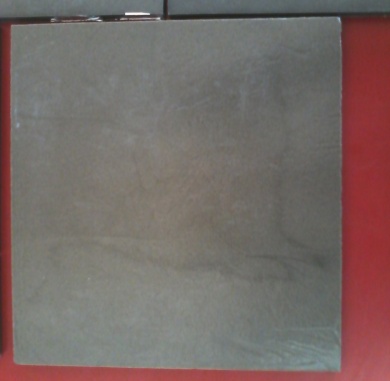 | Figure 1. Prepared ECC composite Board |
|
 | (1) |
 | (2) |
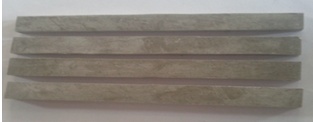 | Figure 2. Flexural Test Specimen |
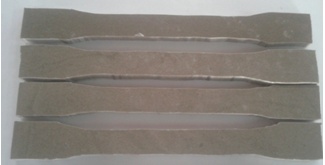 | Figure 3. Tensile Test Specimens |
 | (3) |
 | (4) |
 | (5) |
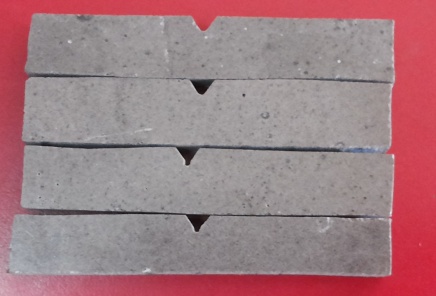 | Figure 4. Impact Test Specimen- |
3. Results and Discussion
- The results obtained from the mechanical tests carried out are presented in Figures 5-8 and the mechanical properties in relationship with the MWCNT content are also shown.
3.1. Flexural Test
- Flexural properties of ECC composites are as sown in figure 5 and 6. As seen from Figure 5 and 6 by adding the small percentage of MWCNT enhance the flexural strength and flexural modulus. MOR value for ECC specimens range from 46.28 MPa to 27.42 MPa is greaterfor 0.1% loading. MOE value for ECC specimens range from 6932.2MPa to 4123.44MPa is greater for 0.2% loading. It is observed that the flexural properties of epoxy / Cenosphere / MWCNT hybrid composites were relatively greater than the epoxy / cenosphere fibre composites. The increment of flexural modulus is attributed to the reinforcing ability of the MWCNT. For 0.3% onwords MWCNT loading, MOR and MOE value reduces. The increase in MOR and MOE is due to the dispersion of CNT and stronger interfacial bonding between the matrix and nanotubes in the composites. Reduction is due to the agglomeration of MWCNT fillers in the composites, formation of voids and porosity for higher loading of MWCNT. The maximum MOR of 46.86 MPa is found for 0.1% MWCNT. The maximum MOE of 6932.2MPa is found for 0.2% MWCNT.Similar observation has been reported by there searcher in the study onepoxy / glass fiber/MWCNT hybrid composites [9, 17] and oncarbonnanofiber / epoxy composites [6]. Results show that there was a drop in the value of bending modulus, because of their high aspect ratio and of Vander Waalsstriking interfaces. CNFs may twist and produce agglomeration at higher concentration thereby decreasing the bending property.
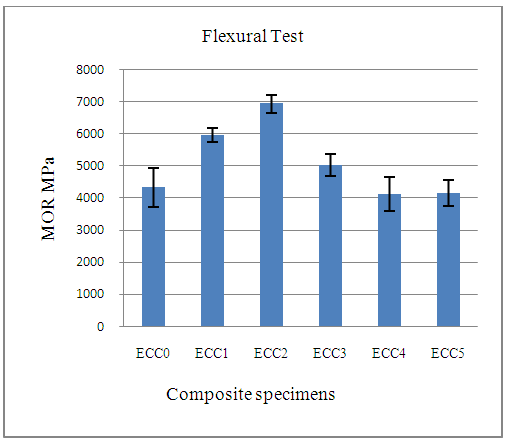 | Figure 5. MOR of ECC samples |
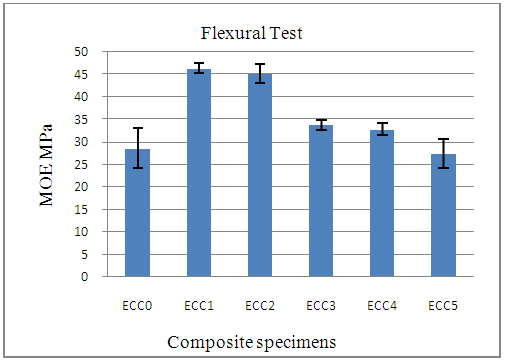 | Figure 6. MOE of ECC samples |
3.2. Tensile Test
- The tensile strength and tensile modulus behavior of Cenosphere/MWCNT particle reinforced composites is shown in Figure 7 and 8, which clearly indicates that tensile strength increases up to 0.2% of MWCNT. It is also observed that the tensile property has a marginal variation between 0.2% and 0.4% of MWCNT content; however it reduces greatly at 0.4%. Increase in the tensile properties is due to addition of high aspect ratio MWCNTs that act as links at micro-crack initiation sites or propagation paths. During the failure process, the link effect will efficiently delay the crack initiation and propagation in the form of MWCNT pull out or break. The cause of agglomeration defects counteracted the effects of the above mentioned mechanisms in reducing the dispersity of the modulus. Interfacial characteristics between the MWCNTs and the polymermatrix have been studied by researchers using both experimental and computational methods. The results found out were similar [16]. The maximum tensile strength of 23.29MPa found experimentally for 0.1% MWCNT weight of epoxy based composite. The maximum tensile modulus of 876.02MPa found experimentally for 0.2% MWCNT weight of epoxy based composite. The analytical studies also suggest that the tensile strength of the nonocomposites are increased by 25.4% for 1% MWCNT and 50.8% for 2% MWCNT, respectively [4].
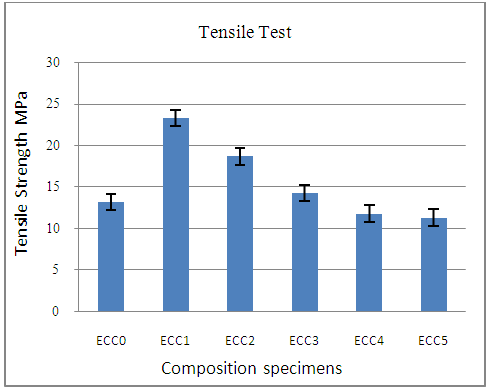 | Figure 7. Tensile strength of ECC samples |
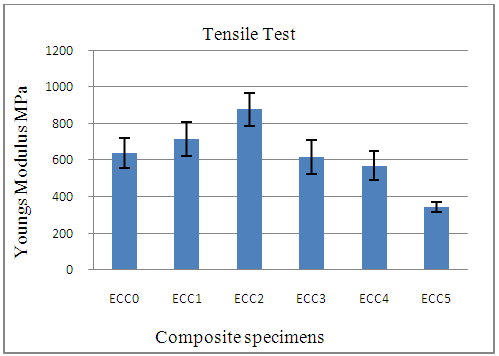 | Figure 8. Young’s modulus of ECC samples |
3.3. Impact Test
- The figure 9 explains about the variation of impact strength property of Cenosphere/MWCNT particle reinforced polymer composites. Experimentally it is found that the impact strength of Cenosphere/MWCNT reinforced composites enhances with increase in %MWCNT loading. It is suggested that the MWCNT could have hindered and delayed the crack propagation in the ECC system through the bridging mechanism in resin-rich region. Hence, moreenergy is needed to break-up or pull out the MWCNT from epoxy matrix. Impact strength is increased by 71% in contrast to plain Cenosphere/Epoxy Composite. The experiment depicts the increase in the impact strength of ECC composites with the increase of MWCNT loading up to 1wt% and decreases beyond that. However, above 1wt% of MWCNT loading, the impact strength was reduced. This can be due to the agglomeration of MWCNT.
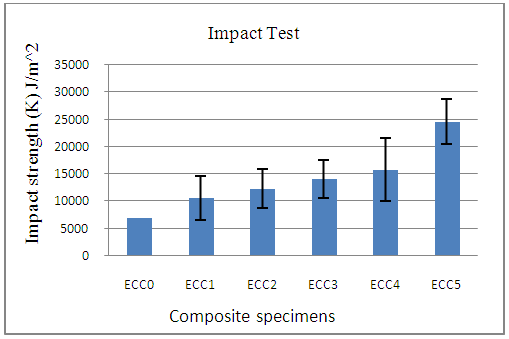 | Figure 9. Impact strength of ECC samples |
4. Conclusions
- The primary objective of this experimental study was to prepare the composite from thermal power plant waste such as cenosphere. This study investigated the feasibility of using MWCNT and Cenosphere particles in polymer for the manufacture of composite panel. The result show that a useful composite with moderate strength could be successful using a MWCNT & cenosphere particles in epoxy resin. These composites found to have good mechanical properties. There is enhancement in the modulus rupture and modulus of elasticity due to addition small amount of MWCNT in cenosphere and epoxy composite. The highest tensile, bending strength were observed at 0.2% of MWCNT loading. Similarly highest impact strength was observed under 0.5 % MWCNT. It is observed that beyond 0.2wt % loading MWCNT reduces the strength of the composite possibly due to agglomeration.
 Abstract
Abstract Reference
Reference Full-Text PDF
Full-Text PDF Full-text HTML
Full-text HTML